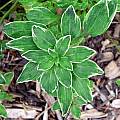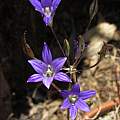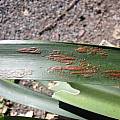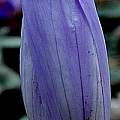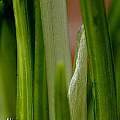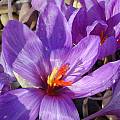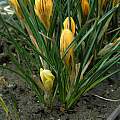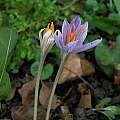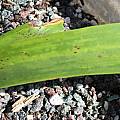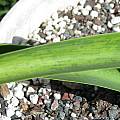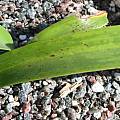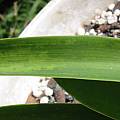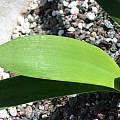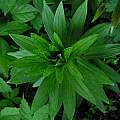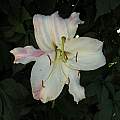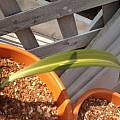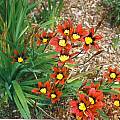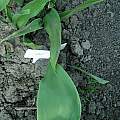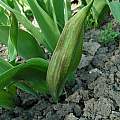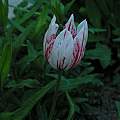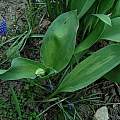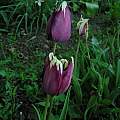Today a significant number of threatened, endangered or extinct (in habitat) geophytes species are grown ex situ by hobbyists, institutions for conservation, as well as commercial growers large and small. In some cases only one clone of an endangered or rare species has been introduced into general cultivation. Sometimes tragically, the single clone becomes infected, and if it is self-sterile, there is little hope to obtain virus-free seedlings from it. Therefore, it is of utmost importance for all to exercise due diligence in ferreting out infected plants from our collections. This can be a tedious and an emotionally charged task, due to the rarity of and personal bonds formed with some of our cherished specimens.
Virused plants may show symptoms such as streaked or mosaic patterns on flowers and foliage. Leaves and stems can be twisted, distorted, and necrosed. Some apparently healthy plants do not show viral symptoms and only under stress that a latent virus may begin to show. In other cases, there are plants that do not show signs of disease at all. Example of such stress could be incorrect watering, inappropriate light exposure, temperatures outside ideal range, or fertilization. The best manner to determine the status of a plant in question is to have it tested by a lab.
Viruses may be spread by insects such as aphids, thrips, leaf hoppers, mealybugs, nematodes, snails, slugs, fungi, or mechanically. Possible mechanical transmission can occur via micro-abrasions as leaves rub against each other, handling with human hands that have virus particles on them (e.g. a tobacco smoker's unwashed hands), chewing by animals and birds that have chewed first on virused material, or by all manner of garden implements that have not been sterilised between the handling of each clone (secateurs, shears, scissors, trowels, shovels etc.). Not all of the viruses listed below spread in the same manner, but for those who desire to keep a virus free collection, a few generally accepted precautions can be taken:
- Virused plants should be discarded, along with any containers and soil that has been in contact with the diseased plant. If containers are to be recycled (plastic only), they need to be submerged in a 10-15% bleach solution overnight, then washed with warm soapy water.
- Sterilise tools with a bleach solution (15-20%) or a source of heat strong enough to kill viruses, between cutting EACH plant.
- Keep a keen eye out for sucking insects that often spread virus, and treat infestations as expeditiously as possible. It is entirely possible for these insects to spread viruses from non-geophytic plants.
- Those who smoke may unknowingly carry a mosaic virus on their fingers (due to tobacco's notorious reputation as a reservoir for many strains of mosaic viruses) thus, thorough washing of ones hands ought to be done before handling leaves, flowers, etc.
- One has a better change of obtaining virus-free material from growers that certify that their stock is seed-grown. It is wise to keep newly acquired plants quarantined. Plants should be tested if one has any doubts.
- With a few exceptions, the most reliable manner in which to obtain virus-free stock is by germinating ones own geophytes from seed.
- In the case of a an infected rare specimen that is hard to part with, a suggestion would be to quarantine it in hopes of getting virus-free seeds before discarding the mother plant. This can be a painful decision if the plant is not self-fertile. When pollinating a virused clone with a healthy clone of a species, it may be better to use the virused plant as the receptor of the pollen (mother of the seed), as sometimes pollen from a virused plant may infect the healthy plant if applied sexually.
Alstroemeria can have several types of virus. The photo below by Susan Hayek illustrates a virused plant with mosaic symptoms.
Brodiaea and other members of the Themidaceae are very susceptible to viruses, causing irregular streaking of the petals and uneven purple breaks at the lower portion of the leaves where they meet the soil. The photo below by Nhu Nguyen shows virused flowers of Brodiaea elegans.
Clivia leaves can show virus symptoms. This photo by Germán Roitman shows that this plant may have more than one problem.
Crocus are susceptible to virus disease. This is usually visible in the flowers. This distortion may take the form of twisted petals, streaking (as in tulip fire,) sometimes the flowers are depauperate and fail to open properly. The virus also reveals itself as light and dark blotching in the foliage which is most visible when the foliage first emerges. The pictures here have been manipulated to exaggerate the streaking in flower and foliage to make it more apparent. (Massive hike in contrast levels does this.) The vectors are aphids which find refuge especially on the backs of the leaves. The third picture shows one with distorted petals. The last two photos show a clean Crocus medius and one that has streaking in the petals that is virused. Pictures courtesy of Tony Goode.
The first photo below is of a plant with Cucumber Mosaic Virus (CMV) which has more than 1000 different hosts and more than 60 species of aphids can spread it. Often we can see multiple virus infections in one plant. These plants, if they flower, have serious distortions, like in the second photo of Crocus speciosus which is infected with CMV and Iris Severe Mosaic Virus. Photos below from Janos Agoston.
Hippeastrum pictures below taken by Germán Roitman show the mottled and streaked leaves. See Hippeastrum mosaic virus below.
Lilium is also susceptible to many viruses. Some of the lily viruses do not cause symptoms, like Lily Symptomless Virus. As in tulips, most infected lilies have leaf mosaic and color break in their flowers, but one can see flower distortion, stunting and decreased bulb growth. The most common lily virus is the Lily Mottle Virus (LMoV). Formerly it was described as the Lily strain of Tulip Breaking Virus, but this "strain" is not able to infect tulips and molecular evidence shows it is a different species in the virus family Potyviridae. The following pictures are demonstrative examples of virus symptoms in lilies.
Virused Phaedranassa photographed by Jennifer Hildebrand. Virus in Phaedranassa, Eucrosia, Eucharis, Stenomesson, Griffinia and Eustephia shows as longitudinal ridges (those leaves are perfectly flat if healthy), besides the mosaic stripes.
The pictures below show Sparaxis with color breaks in the flowers. These plants were very vigorous and increased rapidly in the garden and I had no idea they were virused. Photo by Mary Sue Ittner. These pictures were referenced during a PBS list discussion about virus, see here and here.
The pictures below show Tulip hybrids infected with viruses. Notice the color break and leaf symptoms. Photos by Janos Agoston
Tulip Breaking Virus (TBV) was first described in 1928. The 10,000 times diluted sap of an infected tulip can still infect a healthy one. Member of the virus family Potyviridae.
Photos 1-2 below show early leaf symptoms of TBV. Years after infection the original colour and shape of the tulip can be masked by TBV, like on this unidentifiable red tulip. Photo 3 illustrates this. Viruses not only break colours, but also reduce fertility, vigor, bulb growth, and also reduce stem length. This is shown in photo 4 of a Tulipa Single Late 'Kingsblood'
There are several other Potyviruses which can infect tulips, like the Tulip Band Breaking Virus and the Tulip Top Breaking Virus. Tulip Band Breaking Virus causes basal, wide mosaic on tulips, while Tulip Breaking virus causes thin, line mosaic.
Unfortunately other polyphagous viruses can infect tulips too, like Cucumber Mosaic Virus. It does not cause leaf mosaic, or very mild mosaic, but on the flowers it makes thin color breaks like on this Tulipa Darwin-hybrid 'Big Chief'
The list below was created by Nhu Nguyen and Uluwehi Knecht as a resource for bulb growers who are concerned about bulb viruses. The focus is on geophytes and is by no means inclusive. Most of the data came from the NCBI (National Center for Biotechnology Information) Universal Virus Database which gathered these data from many sources over decades of research. A few important caveats about the list below: Species and families listed are limited to those subjected to testing. This does not mean that these are the only ones that can be infected. Some geographic information date back to the 1950's. As a result of bulb movement throughout the world, some of these viruses have likely spread further than reported here. From this database, it seems that some viruses are host specific, but others spread prolifically and rapidly. Because of unknown species range, it is assumed that all members of a family are susceptible if one species is susceptible. You will find below that sometimes this is not the case, revealed only through testing of multiple species within a family. All families known to be susceptible are listed as a precaution for those who grow both dicots and monocots. And finally, non-persistent means that the virus is lost when the host insect molts; it does not mean that the virus has or will disappear from the plant.
Alstroemeria mosaic virus
- Susceptible geophyte: Alstroemeria caryophylla and Alstroemeria psittacina
- Susceptible families: Alstroemeriaceae, Chenopodiaceae, Solanaceae, Tetragoniaceae
- Symptoms: some flower break and variable leaf chlorosis
- Transmission & vector: by aphids such as Myzus persicae; non-peristant; by mechanical inoculation, not by contact between hosts, seeds, nor pollen.
- Geographical distribution: The virus spreads in Eurasia and North America. The virus occurs in the Netherlands and the USA.
Alstroemeria streak virus
- Susceptible geophyte: Alstroemeria spp.
- Susceptible families: Alstroemeriaceae, Chenopodiaceae, Solanaceae, Tetragoniaceae
- Symptoms: streaking, stunting and mosaic of leaves.
- Transmission & vector: by aphids such as Macrosiphum euphorbiae and by mechanical inoculation; not transmitted by contact between hosts.
- Geographical distribution: The virus is found, but with no evidence of proliferation, in Netherlands, UK and USA.
Alstroemeria virus
- Susceptible geophyte: Alstroemeria caryophylla 'Ligtu' hybrids.
- Susceptible families: Alstroemeriaceae, Amaranthaceae, Chenopodiaceae, Fabaceae, Solanaceae, Tetragoniaceae
- Symptoms: faint chlorosis.
- Transmission & vector: by mechanical inoculation; not transmitted by contact between hosts.
- Geographical distribution: The virus is found, but with no evidence of proliferation, in England.
Amazon lily mosaic virus
- Susceptible geophyte: Eucharis grandiflora
- Susceptible families: Amaryllidaceae, Chenopodiaceae, Solanaceae
- Symptoms: Leaf mosaic
- Transmission & vector: insects, particularly aphids Myzus persicae; non-persistent.
- Geographical distribution: unknown
Dahlia mosaic virus
- Susceptible geophyte: Dahlia pinnata
- Susceptible families:
- Symptoms: chlorotic vein-banding, mosaic and leaf malformation.
- Transmission & vector: by 16 species, notably Aphis fabae, Myzus persicae and Macrosiphum euphorbiae; non-persistent.
- Geographical distribution: probably distributed worldwide.
Crinum mosaic virus
- Susceptible geophyte: Crinum ssp.
- Susceptible families: Amaryllidaceae
- Symptoms: pale streaking, then mosaic and general chlorosis.
- Transmission & vector: unknown
- Geographical distribution: Australia and Fiji (Brunt, 1980)
Eucharis mottle virus
- Susceptible geophyte: Eucharis candida
- Susceptible families: Amaryllidaceae, Amaranthaceae, Chenopodiaceae, Cucurbitaceae, Fabaceae-Papilionoideae, Solanaceae, Tetragoniaceae
- Symptoms: leaf mottling
- Transmission & vector: by mechanical inoculation; transmitted by seeds.
- Geographical distribution: Peru
Freesia leaf necrosis virus
- Susceptible geophyte: Freesia refracta
- Susceptible families: Iridaceae, Chenopodiaceae, Solanaceae.
- Symptoms: chlorotic flecks and spots in leaves, which become necrotic. Symptoms more severe when plants are stressed by bright light or waterlogging. Flowers and corms unaffected.
- Transmission & vector: transmitted by chytrid fungi such as Olpidium brassicae, and by mechanical inoculation (with difficulty). Not transmitted by seeds.
- Geographical distribution: The virus spreads in Eurasia. The virus occurs in Germany, Ireland, Italy, the Netherlands, and the United Kingdom.
- Control: Studies reported by The virus occurs in soil and is spread by infected corms, hence it is controlled by soil treatment and corm choice. This virus, together with freesia mosaic virus, causes freesia streak disease (Brunt, 1974; Van Dorst, 1973).
Freesia mosaic virus
- Susceptible geophyte: Freesia refracta, Lilium formosanum
- Susceptible families: Iridaceae, Liliaceae, Amaranthaceae, Caryophyllaceae, Chenopodiaceae, Asteraceae, Cruciferae, Cucurbitaceae, Fabaceae, Solanaceae.
- Symptoms: mild chlorosis to symptomless
- Transmission & vector: aphid vectors such as Macrosiphum euphorbiae, Myzus persicae; non-persistent; mechanical inoculation, not by contact between hosts, seeds nor pollen.
- Geographical distribution: occurs in Australia, Ireland, the Netherlands, and the United Kingdom. The virus is found, but with no evidence of proliferation, in New Zealand.
Hippeastrum mosaic virus
- Susceptible geophyte: Hippeastrum hybridum, Hippeastrum equestre, Eucharis grandiflora; (Belamcanda chinensis, Dahlia pinnata, Tropaeolum majus do not show signs of susceptibility)
- Susceptible families: Amaryllidaceae, Chenopodiaceae, Solanaceae.
- Symptoms: chlorotic streaking of leaves and flower stalks
- Transmission & vector: by aphids such as Aphis fabae, Aphis gossypii, Myzus persicae, mechanical inoculation; not by contact between hosts, seeds, nor pollen.
- Geographical distribution: unknown
Hyacinth mosaic virus
- Susceptible geophyte: Hyacinthus orientalis; (Lilium formosanum does not show signs of susceptibility)
- Susceptible families: Hyacinthaceae
- Symptoms: leaf chlorosis, stem spotting, occasional flower break.
- Transmission & vector: by aphids such as Myzus persicae, Macrosiphum solanifolii; non-persistent; mechanical inoculation, not by contact between hosts, seeds, nor pollen.
- Geographical distribution: Australia, Bulgaria, the Netherlands, the United Kingdom, and the United States of America.
Iris fulva mosaic virus
- Susceptible geophyte: Iris fulva and hybrids with Iris fulva, Iris sibirica; (Iris spuria, Neomarica gracilis do not show signs of susceptibility)
- Susceptible families: Iridaceae, Amaranthaceae, Chenopodiaceae.
- Symptoms: faint to prominent mosaic, necrosis, malformation of leaves and seed pods.
- Transmission & vector: Virus is transmitted by mechanical inoculation; not transmitted by seeds.
- Geographical distribution: USA
Iris mild mosaic virus
- Susceptible geophyte: Iris ssp., bulbous irises, Iris xiphoides, I. xiphium, I. tingitana x I. xiphium, I. reticulata, and I. danfordiae, Belamcanda chinensis
- Susceptible families: Iridaceae, Chenopodiaceae, Solanaceae, Tetragoniaceae.
- Symptoms: mild mosaic
- Transmission & vector: by aphids such as Aphis gossypii, Macrosiphum euphorbiae, and Myzus persicae; non-persistent); but not by Macrosiphoniella sanborni. Virus is not transmitted by seeds.
- Geographical distribution: The virus is probably distributed worldwide (most important cultivars are totally infected).
- Geographical distribution: unknown
Iris severe mosaic virus
- Susceptible geophyte: Iris ssp., Iris x hollandica, Crocus vernus cv. King of the Blues, Belamcanda chinensis; (Freesia refracta cv. Imperial do not show signs of susceptibility).
- Susceptible families: Chenopodiaceae, Iridaceae, Solanaceae.
- Symptoms: Crocus vernus shows leaf mosaic, striping of flowers (either white or yellow). Belamcanda chinensis shows severe chlorosis. Iris ssp. show leaf striping, stunting, flower breaking. Plants die prematurely.
- Transmission & vector: by aphids such as Macrosiphum euphorbiae and Myzus persicae; not by Myzus pelargonii, M. circumflexum, Anuraphis tulipae, Rhopalosiphum tulipaella. Virus is transmitted by mechanical inoculation; not transmitted by grafting nor contact between hosts.
- Geographical distribution: Australia, Czechoslovakia (former), Denmark, Japan, the Netherlands, Sweden, the United Kingdom, and the United States of America (and probably wherever bulbous and rhizomatous irises and crocus are grown).
- Control: Studies reported by Deutsch and Loebenstein (1967), the spread of the virus in bulbous iris can be partially controlled by spraying crops with mineral oils or pyrethroid and perimicarb insecticides.
Leek yellow stripe virus
- Susceptible geophyte: Allium porrum, Allium cepa var. ascalonicum; (Allium fistulosum do not show signs of susceptibility)
- Susceptible families: Alliaceae, Amaranthaceae, Chenopodiaceae, Solanaceae.
- Symptoms: yellow leaf stripes
- Transmission & vector: by aphids and mechanical inoculation; not by contact between hosts nor seeds.
- Geographical distribution: The virus spreads in Eurasia; occurs in New Zealand (Aotearoa).
Lily mottle virus
- Susceptible geophyte: Lilium spp.
- Susceptible families: Liliaceae
- Symptoms: not listed from the source, but probably mottling of leaves as the name implies.
- Transmission & vector: unknown
- Geographical distribution: Germany, Israel, the Netherlands, and the USA.
Narcissus degeneration virus
- Susceptible geophyte: Narcissus tazetta cv. Grand Soleil d'Or
- Susceptible families: Amaryllidaceae
- Symptoms: not listed from source, but probably degeneration of plants as the name implies.
- Transmission & vector: unknown
- Geographical distribution: unknown
Narcissus late season yellows virus
- Susceptible geophyte: Narcissus pseudonarcissus
- Susceptible families: Amaryllidaceae
- Symptoms: not listed from source, but probably yellowing of leaves as the name implies.
- Transmission & vector: unknown
- Geographical distribution: unknown
Narcissus latent virus
- Susceptible geophyte: Narcissus pseudonarcissus cv. Golden Harvest, Gladiolus cv. Scarlet Royal, Iris xiphium cv. praecox x I. tingitana (syn. Iris hollandica), other bulbous irises, Narcissus pseudonarcissus, Nerine sarniensis cv. Rotherside.
- Susceptible families: Amaryllidaceae, Iridaceae, Fabaceae, Solanaceae (highly infectious in many species), Tetragoniaceae.
- Symptoms: systemic to non-systemic chlorotic spotting, faint to dark local lesions, veins bending. These symptoms occur differently on different hosts.
- Transmission & vector: aphids such as Acyrthosiphon pisum, Myzus persicae, Aphis gossypii; non-persistent; mechanical inoculation, not transmitted by contact between hosts, seeds, or pollen.
- Geographical distribution: unknown
Narcissus mosaic virus
- Susceptible geophyte: Narcissus pseudonarcissus, Lilium speciosum, Nerine spp.
- Susceptible families: Amaryllidaceae, Amaranthaceae, Apocynaceae, Chenopodiaceae, Asteraceae, Fabaceae-Papilionoideae, Solanaceae, Tetragoniaceae, Umbelliferae.
- Symptoms: symptomless in N. pseudonarcissus; in Lilium severe yellow stripe on leaves, leaf-deformation and stunting, as well as, in some cases, premature death of the plants.
- Transmission & vector: mechanical inoculation; not transmitted by contact between hosts (between narcissus plants), not transmitted by seeds.
- Geographical distribution: The virus is probably distributed worldwide (in all countries which have imported narcissus and nerine from Europe). The virus occurs in particularly the Netherlands and the United Kingdom.
Narcissus tip necrosis virus
- Susceptible geophyte: Narcissus pseudonarcissus, N. tazetta, N. poeticus (Belamcanda chinensis, Dahlia pinnata do not show signs of susceptibility)
- Susceptible families: Amaryllidaceae, Chenopodiaceae, Solanaceae, Tetragoniaceae.
- Symptoms: usually symptomless; sometimes general leaf local chlorosis (2 mm), elongate chlorotic areas near leaf tips, later becoming brown and necrotic, premature leaf senescence, not systemic.
- Transmission & vector: Virus is transmitted by mechanical inoculation; not transmitted by grafting. Hosts become infected only by inoculation with purified virus preparations, never directly from infected Narcissus sap.
- Geographical distribution: Netherlands and the United Kingdom.
Narcissus yellow stripe virus
- Susceptible geophyte: Narcissus ssp.
- Susceptible families: Amaryllidaceae
- Symptoms: not listed from source, but probably yellow stripping of leaves as the name implies
- Transmission & vector: unknown
- Geographical distribution: The virus spreads in Eurasia and possibly occurs in Australia.
Nasturtium mosaic virus
- Susceptible geophyte: Tropaeolum majus
- Susceptible families: Tropaeolaceae
- Symptoms: vein clearing, mottling and slight leaf malformation; occasionally flower breaking.
- Transmission & vector: by aphids such as Aphis fabae, Dysaphis apifolia, Myzus persicae, Aulocorthum circumflexum, Rhopalosiphum padi; non-persistent; by mechanical inoculation.
- Geographical distribution: Brazil, South Africa, the United Kingdom, and the USA.
Nerine latent virus
- Susceptible geophyte: Nerine bowdenii, Hippeastrum hybridum; (Belamcanda chinensis, Dahlia pinnata, Tropaeolum majus do not show signs of susceptibility).
- Susceptible families: Amaryllidaceae, Amaranthaceae, Chenopodiaceae, Solanaceae.
- Symptoms: symptomless in H. hybridum
- Transmission & vector: by aphids such as Myzus persicae; non-persistent; by mechanical inoculation but not by contact between hosts, seeds nor pollen.
- Geographical distribution: The virus occurs in the Netherlands and the United Kingdom.
Nerine virus X
- Susceptible geophyte: Nerine sarniensis, Agapanthus praecox ssp. orientalis; (Allium cepa, Belamcanda chinensis, Dahlia pinnata, Hippeastrum hybridum, Lilium cv. Enchantment, Lilium formosanum, Narcissus pseudonarcissus do not show signs of susceptibility).
- Susceptible families: Amaryllidaceae, Amaranthaceae, Chenopodiaceae, Fabaceae, Solanaceae, Tetragoniaceae.
- Symptoms: symptomless in N. sarniensis and A. praecox ssp. orientalis to chlorotic or necrotic local lesions, then systemic chlorosis.
- Transmission & vector: mechanical inoculation, contact between hosts; not by seeds nor pollen.
- Geographical distribution: unknown
Nerine Y virus
- Susceptible geophyte: Nerine sarniensis
- Susceptible families: Amaryllidaceae
- Symptoms: severe leaf chlorosis
- Transmission & vector: unknown
- Geographical distribution: New Zealand (Aotearoa) and the United Kingdom
Nerine yellow stripe virus
- Susceptible geophyte: Nerine sarniensis, Nerine bowdenii; (Alstroemeria caryophylla, Belamcanda chinensis, Dahlia pinnata, Lilium formosanum do not show signs of susceptibility).
- Susceptible families: Amaryllidaceae, Chenopodiaceae, Solanaceae, Tetragoniaceae.
- Symptoms: causes chlorotic streaking in N. sarniensis and chlorotic mosaic in N. bowdenii.
- Transmission & vector: by aphids; transmitted by mechanical inoculation but not by contact between hosts.
- Geographical distribution: the Netherlands and the United Kingdom.
Nothoscordum mosaic virus
- Susceptible geophyte: Nothoscordum fragrans; (Allium cepa and Lilium formosanum do not show signs of susceptibility).
- Susceptible families: Liliaceae
- Symptoms: not listed from source, but probably leaf mosaic as the name implies.
- Transmission & vector: unknown
- Geographical distribution: the USA (Louisiana) and the Canary Islands
Ornithogalum mosaic virus
- Susceptible geophyte: Ornithogalum thyrsoides, Ornithogalum spp. and hybrids, Lachenalia spp. and hybrids; (Iris germanica, Lilium longiflorum, Narcissus jonquilla, Nerine bowdenii do not show signs of susceptibility).
- Susceptible families: Hyacinthaceae, Chenopodiaceae, Solanaceae, Tetragoniaceae.
- Symptoms: Ornithogalum ssp. and hybrids show mottling of leaves and stems, flowers deformed. Lachenalia ssp. and hybrids show mosaic or mottling of leaves and flower stems, flowers deformed.
- Transmission & vector: by aphids such as Myzus persicae and mechanical inoculation.
- Geographical distribution: The virus occurs in the Netherlands, South Africa, and the USA.
Tuberose mild mosaic virus
- Susceptible geophyte: Polianthes tuberosa
- Susceptible families: Liliaceae
- Symptoms: irregular foliar mottling
- Transmission & vector: unknown
- Geographical distribution: New Zealand (Aotearoa).
Tulip breaking virus
- Susceptible geophyte: Calochortus, Fritillaria pudica, Lilium (cvs. Concorde, Sterling Star), Lilium formosanum, Lilium longiflorum, Ornithogalum thyrsoides, Tulipa spp., Tulipa hybrids, Zigadenus fremontii; (Allium cepa, Hippeastrum hybridum, Hyacinthus orientalis, Narcissus pseudonarcissus show no signs of susceptibility).
- Susceptible families: Calochortaceae, Hyacinthaceae, Liliaceae, Melanthiaceae.
- Symptoms: Tulipa ssp. and Darwin hybrids show colour-breaking of flowers and leaf chlorosis. Lilium ssp. and Mid-Century hybrids show leaf chlorosis and degeneration.
- Transmission & vector: by aphids such as Myzus persicae, Aphis gossypii, Aphis fabae, Macrosiphum euphorbiae, Dysaphis tulipae, Aulocorthum circumflexum; non-persistent.
- Geographical distribution: probably distributed worldwide.
Tulip chlorotic blotch virus
- Susceptible geophyte: Tulipa ssp.
- Susceptible families: Liliaceae, Amaranthaceae, Chenopodiaceae, Fabaceae-Papilionoideae, Solanaceae, Tetragoniaceae.
- Symptoms: blotching or streaking of leaves in Tulipa spp; Flower break symptoms indistinguishable from those caused by tulip breaking virus. In other hosts, symptoms include systemic chlorotic mottle and chlorotic local lesions.
- Transmission & vector: Virus is transmitted by mechanical inoculation.
- Geographical distribution: Australia.
Tulip virus X
- Susceptible geophyte: Tulipa spp., Lilium formosanum.
- Susceptible families: Liliaceae, Amaranthaceae, Amaryllidaceae, Chenopodiaceae, Cucurbitaceae, Fabaceae-Papilionoideae, Solanaceae, Tetragoniaceae, Umbelliferae, Violaceae.
- Symptoms: chlorotic or necrotic grey-brown streaking of leaves; streaks of intensified pigment (or of necrosis) in petals.
- Transmission & vector: not transmitted by a vector; manual inoculation of tulips is only occasionally successful, thus spread by contact between plants may be rare; not by mechanical inoculation and probably not transmitted by contact between hosts.
- Geographical distribution: unknown
Tropaeolum virus 1 & 2
- Susceptible geophyte: Tropaeolum tuberosum
- Susceptible families: Tropaeolaceae, Asteraceae, Solanaceae
- Symptoms: leaf chlorosis
- Transmission & vector: by aphids such as Myzus persicae; by mechanical inoculation; not by seeds. Tropaeolum viruses 1 and 2 frequently occur as a mixture = isanu mosaic virus in Tropaeolum tuberosum.
- Geographical distribution: unknown
